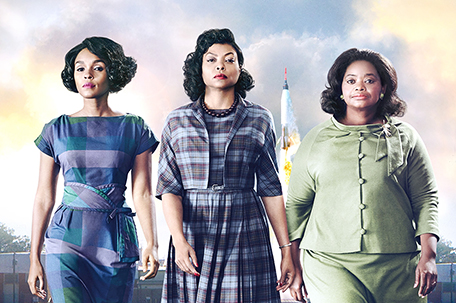
By Aramide A. Tinubu
shadow and act
It is no secret that American history is often white-washed and male-centered, erasing the dedicated work of women and people of color; especially Black women who have worked tirelessly throughout time to make this country what it is today. The story of Katherine Johnson, Dorothy Vaughan and Mary Jackson, Black female scientists and mathematicians who played an integral role in getting the United States into the race for human space flight is just one of those stories. Based on the compelling book by Margot Lee Shetterly, Hidden Figures tells the story of this visionary trio of women who crossed every barrier in order to make space travel possible.
Recently at a press conference in New York City, I got the opportunity to sit down with Taraji P. Henson (Katherine Johnson), Octavia Spencer (Dorothy Vaughan), Hidden Figures author Margot Lee Shetterly, producer Pharrell Williams, Director Ted Melfi, NASA Astronaut Stephanie Wilson and NASA Historian Bill Barry. The cast and crew discussed why they were inspired to come on to the project, what they learned from the real-life figures, and why this history is so important today.
Hidden Figures is a film about bringing everyone together. Can you discuss how you brought the cast together?
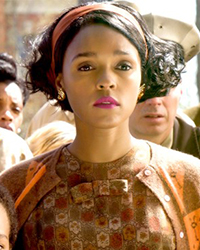
Janelle Monáe
Theodore Melfi: Octavia Spencer was the first actor to read the screenplay, and she said she wanted to be involved right away. She couldn’t even decide which role, but she decided she wanted to be involved. When I got the script and the book proposal… it all started with a fifty-five-page book proposal that Margot Lee Shetterly wrote. Margot grew up around these amazing women. I’ve also wanted to work with Taraji [P. Henson] since I saw The Curious Case of Benjamin Button. I thought she was just brilliant in it, so watching her grow to Cookie on “Empire,” I knew she could pretty much do anything. She’s a consummate actor first and foremost. Then, Janelle Monáe, I wanted someone new and fresh, and Janelle came in and auditioned and strangely enough fought for the part just like her character fights for her rights in the film.
Taraji and Octavia, since you are playing women who actually existed and did all of these things, how important was it for you to know about them personally, versus just the film version of these women?
Taraji P. Henson: When you are portraying a person that is very real, in my case, Katherine [Johnson] is still alive, she is 98-years old, and there is a responsibility to get it right. So, as soon as I signed on to the project, I asked Ted immediately if she was still alive. When he said yes I said, “I have to meet her immediately.” At the time she was 97, so I flew down with Ted, and when we got there, her daughters came out and met me and they were so happy. They said, “We’re so glad they got you to play our mother.” I was like, “No, pressure.” (Laughing) I went in to sit with Katherine, and it was like waiting for the queen. That’s how it felt. She came in, and I was just like, “Wow, I’m in the presence of a real life superhero.” I guess the biggest thing that I took away from Katherine was her humility. When you talk about superheroes there are selfless, they don’t think about themselves, they put humanity first. I talked to her, and I tried to make it weighty by asking things like, “How as a Black woman did you do it? They were misogynistic, and I’m sure you got called the n-word.” She was just like, “Well, that was the way it was. I just did my job. I wanted to do my job.” She was just so humble. She would always say, “we.” In my mind I’m like, “No, Katherine it was you. It was your mind alone that got [John] Glenn to orbit the earth.” He didn’t say, “Go get so in so.” He said, “Go get that smart girl.” But that fact that that she sees the “we” in “I,” blew me away. Also her passion for math, the way I light up when I get asked questions about acting is the way her eyes danced when she talked about math and how she wanted people to fall in love with numbers the way that she did. If I had a teacher like that, I could have been a rocket scientist. When I was growing up, no one ever said to me, “You cannot do math because you’re a girl.” But, there was an understanding growing up that math and science were for boys. Somebody lied to me because this woman exists, all of these women existed. I made it my mission to do this film right because I didn’t want another girl to grow up believing the myth and the lie. I’m gonna give it to Octavia because I can go on and on.
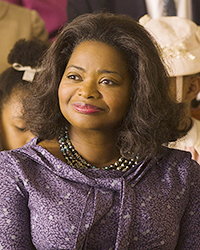
Octavia Spencer
Octavia Spencer: (Laughing) Thank you, Taraji. For me, it was a very different process because [Dorothy Vaughan] is no longer with us, but her family is and her legacy remains. Even though I knew I wanted to be a part of the film early on, when I finally knew that it was going and that I was going to be in the movie, it was a three and a half week period; so very little time. I started panicking, and I then thought I should Google and find out as much information about Dorothy as possible. But there was very little. Now if you Google her, you will see a lot of things referring to Margot’s book and you’ll get to see NASA archives, which I got a lot of that and you’ll see a lot of things referring to the film. But, it was important to get it right. It is important to learn as much as you can about the person and then throw it all away so that you’re not in any way doing some sort of mimicry. What was wonderful was that Ted gave us a lot of the archival footage from NASA and then the opening chapters that corresponded to our characters. He didn’t betray Margot by giving us a lot of the main text, he was like, “I’m only giving you the background.”
TPH: The book was being written while the film was being shot, so it happened simultaneously.
OS: Yes. There were lots of moving parts. So for me the research part was integral but, if this is the first time these women are being introduced to the world in this way, there are enough negative images of Black women out there and I did not want to portray [Dorothy] in any stereotype. I wanted to make sure that her integrity was preserved.
The opening scene of the film where the women have a car issue and the cop comes up, it just resonates so well with what’s happening today. Do you think that’s one of the reasons the film is so compelling because it speaks to the world that we are living in now?
OS: The opening scene for me is like this beautiful metaphor of what was to come in their lives; the love and comradery and fidelity that they had with each other as friends. But it was a twisty winding road that they had to navigate and negotiate in a very interesting way and I think Ted did a brilliant job in displaying that.
TPH: He really did! I think that scene is just so powerful because you can feel the whole audience brace themselves when the cop arrives. But what’s beautiful about that scene is that you see this man unlearn racism right before your very eyes, and it proves to you that your perception can change in a manner of minutes. And that’s when you know that racism is learned. He literally sees that these women mattered, these women’s lives mattered to the great space race so that negativity that he was about to spew on to them shifted in a blink of an eye. If we as a human race can all get back to one goal that we can focus on, I think that the world would be more balanced.
TM: I think that opening scene is also a classic example of art imitating life. We wrote that scene and shot that scene long before the string of police shootings against Black motorists. Who could have predicted that? Who could have predicted the passing of John Glenn? These things make the movie even more important to us.
Let’s talk about the juxtaposition between the NASA world and what was happening in real life. Did anyone have a chance to speak with Katherine about what it was like to be in that world and then to step outside and have to battle for human rights?
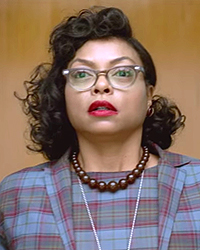
Taraji P. Henson
TPH: I did touch on that when I spoke with her, but what I notice even when I talk to my grandmother or anybody who is from that era is that they didn’t wallow in the muck, they didn’t do that; they just didn’t. Yes, they marched when there was an injustice, but every day was not a march. At some point, they said, “OK, this is what it is. Put your head to the ground, grind and get through it, because your hard work is going to open up doors for those coming behind.” So Katherine never complained, it just was what it was. She just said, “I just wanted to go to work and do my numbers.” And she stopped right there. I think about that as a Black woman in Hollywood when I’m asked about diversity. I hate when people say diversity because the first thing you jump to is Black and white. When you talk about diversity, you’re talking about women being hired in front of and behind the camera. You are talking about people with disabilities, the LGBTQ community…so I hate when people think about diversity, and they look at the Black actor, and they’re like “Go!” It’s like; we’re just scratching the surface. It just doesn’t start with me. We think so small. When I get that question I don’t go, “Yeah, well you know they don’t pay me.” That’s not my story. I own six properties; Hollywood has been damn good to me. Now you can ask me, “Have they paid you what you deserve?” That’s the question, but you’d have to go to the studios, I don’t know. I do the work! But to go back to your point, it gave me this new perspective to stop complaining. There is always going to be love versus hate; we struggle with that as humans within ourselves every day; as a society, we have to struggle. So when you wake up, you have to decide which side you’re going to be on. Hopefully, that side is positive, so you do the work and hope that your legacy will help change things.
Margot, can you talk about when you met Katherine and some of the experiences that you had with her?
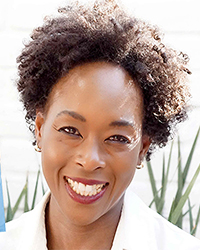
Margot Lee Shetterly
Margot Lee Shetterly: I just want to say sitting with you all and having known these women and listened to their stories and having them trust me with their stories, I cannot even tell you what an honor you have done to these women. You have given them the legacy that they have deserved for a long time. So I just want to say thank you for that and for bringing it to life, it has been such an honor. So, to piggyback off what Taraji said, these women really saw this as an everyday fight with everyday victories. For me, one of the things that is in the film and it’s certainly something that I wanted to show in the book is both how banal and boring and trite and ridiculous so much of this racism and discrimination is. It wasn’t like fire hoses in the street, and the dogs, but it was having everyone think that you are the custodian and things like that. I think a lot of people; all of us in some ways have had experiences like that. I think being able to show that really creates a human bridge to the story. These women knew that every single time they put their pen or pencil to paper and really expanded the imagination of the people around them and themselves, of what they were capable of as Black women and scientists. Every time that happened they were opening the door for more people. We have this idea of the Civil Rights Movement as Martin Luther King, Jr. and all of these things, but this was really part of it. One day at a time by going to work and really bringing their A-game, these women, they did our country a great service, they did women a great service, African-Americans… I mean they are the American dream, so I really hope that everybody who sees this movie regardless of who they are will really hold on to that and take some optimism.
Margot, this is such amazing history. Are there any plans to take the book and place it in schools and universities across the country?
MLS: I hope so! (Laughing) The reception has been really good and a lot of colleges have gotten in touch. MIT selected it for its MIT Reads program. The movie screened at MIT and Harvard and to see a theater full of women engineers and mathematicians has been great. There is a meeting of six thousand mathematicians happening in Atlanta, Georgia. It’s called Joint Mathematics Meetings; they are honoring the women of “Hidden Figures.” These are mathematicians from around the world, the people who are at the top of this field. There is also a young reader’s version of the book for youth, so I really do think the enthusiasm is going to pull this into schools so that this is part of the curriculum of American history.
Amazing! So just to bring Pharrell into the conversation, can you talk a bit about coming onto the project and what you knew about Katherine and these women since you are from the same area?
Pharrell Williams: First of all I just want to say that I’m rarely proud, but I’m super proud to be a part of this project. Donna Gigliotti first brought “Hidden Figures” to my attention. My producing partner, Mimi Valdes took a meeting with her, and when Donna told her about it, Mimi said, “He’s gonna lose his mind.” It’s because it hit so many touch points, so many things that interest me. Three African-American female protagonists that are not arguing, or divorcées, or consoling each other, or not the token best friend; we love those parts, we appreciate them, but this wasn’t that. This was different; this was three African-American protagonists who were scientists, engineers, and mathematicians. They were technologically advanced. The idea that this also included NASA and space; two things I’ve always been obsessed with, and it happened in Hampton Roads. Yes, I lost my mind. (Laughing) When I told my mother about the story, I said, “Mom, this the first movie I’m going to be a producer on.” I explained the difference between a music producer and being a producer on a film; I was so excited about that. She was like; “You met Katherine Johnson six years ago.” I met her at our organization called “From One Hand to Another,” which is largely based on the STEM program. Leland Melvin is an African-American astronaut who brought Katherine to our event, so I met her, but I didn’t know the back-story obviously. So to know that six years ago I met this woman and would one day be able to aid in this beautiful illustration of her story; it has just been mind-blowing. I know this is the scientific community, but there is a God. If you don’t want to call it God, there is a universe. There is a formula for everything including how I got into this film. I believe this was meant for us, and I just feel so blessed that I got to be even a little comma in this story.
TPH: Tell them how you were already working on the music! I find that fascinating.
PW: (Laughing) OK. (Laughing) More proof if you will, that this was meant for all of us. At the end of 2014, I started working on 1960’s- esque music. I didn’t really know why. I stayed with it so much so that I actually released one of the songs; it was called “Freedom”; didn’t know that we would need it today. As soon as I got that call, it was like Eureka; this is what it was. The universe was warming me up and tuning me so that I could prepare myself to write the song “Running “ for the film and write the other song, “I See A Victory” for the film. This project has been blessed seriously. We have real NASA historians and astronauts here to make sure that everything is on par with the truth. It’s amazing.
To that then, Stephanie can you share a bit about how these advancements that these women made affected you at NASA?
Stephanie Wilson: Oh, absolutely. There are so many people that work behind the scenes at the space programs for the space shuttle flights that I’ve had the true blessing and privilege to a part of. There are many people that work in mission control, that work to train us, that work to prepare the systems and the research. Women are a large part of those teams, so it was wonderful to see this early story and to see it so well portrayed, and so well taught and so well written with the book. It’s so amazing to see. I had heard early stories of one woman validating the calculations for John’s flight, but I didn’t know her name, and I didn’t know of the larger group. So it was wonderful to see a large group of women working together as a team to prepare for these missions and to do the validations for these missions. And also, learning about early pioneers that have paved the way. I’ve been fortunate enough to have flown in space after some forty-some-odd women. There are many pioneers that have come before me to pave the way, and it’s been a wonderful privilege to stand on their shoulders and to continue to contribute and to move us forward as far as space flight.
Bill, could you share a bit about your work with Ted on making sure the film was historically accurate?
Bill Barry: Sure! This whole process like Pharrell said is a dream come true for a historian. To have this great story not just from our history and NASA’s history, but also from the history of the human race being told so well, and to have all the materials that we gathered from the NASA history archives and other places. To have someone as brilliant as Margot mining through that stuff to tell that story, that’s amazing. I believe this movie will not only have a huge impact in inspiring all kinds of people to do things, but also inspire the rest of us to remember our humanity and to love one another. The process of getting there was really interesting, because Ted and the production team, they were crazy. (Laughing) They came to us with every question we could possibly imagine, and we worked together and talked about things. A whole bunch of people at NASA were involved in digging up photographs of what the parking lot looked like in 1962 at Langley Research Center. We needed to find out what kind of cars were in it. They wanted to get that right. What was that switch that John Glenn had to adjust so that he could come back in safely? We had to dig up the Owner’s Manual for the Mercury Capsule for that and send it to Ted. It was an amazing process and the dedication of Ted, the production team and the actors to get the story right and getting to the truth of the story for these women and for NASA and our country, it just blew me away. I didn’t imagine it could be this way.
TM: The research that went into the film was painstakingly poured over so we challenge you to find a flaw. (Laughing) Even John Glenn’s quote “Get the smart girl to find the numbers,” those are verbatim quotes. Jim Johnson to his future wife, Katherine Johnson, “I know marrying you means marrying your girls as well.” These are direct quotes. The movie is based on a tremendous amount of research and fact.
OS: Here is another fun fact. The house that my character lives in, the one where we watched all of the launches from is actually the house that all of the Civil Rights leaders would stay at and congregate at in Atlanta. So they did a lot of restoration. It’s a real historical landmark.
TM: We were shooting in a house where Martin Luther King, Jr. walked through and where Ralph Abernathy walked through and had social events. So it really added to the fabric of the film.”
Thank you so much, everyone, it was amazing to speak with you all.
Hidden Figures will premiere in selected theaters on Christmas Day; nationwide on January 6, 2017.




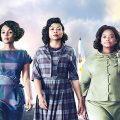
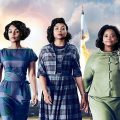










Leave a Comment